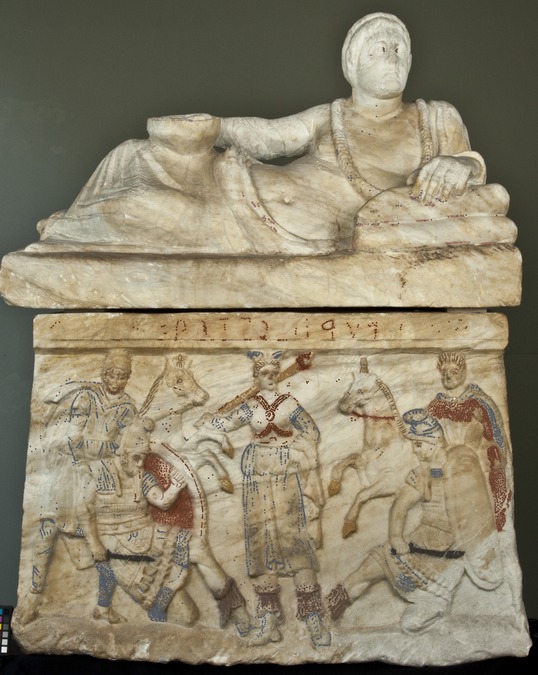Cinerary Urn
Summary
On this Etruscan urn extensive traces of original polychromy is visible to the naked eye. It was found that a fairly wide palette of pigments was used especially different ochre pigments. This included: red, yellow brown and purple ochre but also black, Egyptian blue, and a pink organic colourant. The background was left unpainted and to appear the colour of the marble. Painting was in few cases used as a subsitute for the carving of details. This is the case with the harness on the right horse but also on the upper frame of the relief where traces of a red painted inscription are visible. The garments are richly coloured in red, blue and purple and the inside of the shields are red. On the cushions underneath the deceased’s arm a mixture of Egyptian blue and a pink organic colourant probably madder lake is found. The VIL-imaging reveals a concentration of Egyptian blue in the sclera of the eyeballs of the deceased. On the sea monsters on the narrow sides both red and blue appears.
Description of object
On the lid a male figure is lying with a wreath around the hair and a dotted garland around his neck. In his right hand he holds a phiale mesomphalos while his left hand is resting on cushions. The urn has reliefs on three sides. The relief is work in low relief but the painting helps to make the figures project. The front shows the concluding scene between the two brothers Eteokles and Polyneikes breathing their last. On both the narrow sides sea monsters are facing front. It seem like the urn is a littel small for the lid and it isnot absolutely certain they belong together. The surface of the haed and the lower edge on the narrow sides may have been heavily cleaned and rasped.
Choice of methods
Visual examination
- Macroscopic
- Microscopic in situ
Technical imaging
- UV
- VIL
Sampling
- XRF
Visual examination
Blue and red seems to dominated the colours of the garments of all figures and blue is found of the shoes. Purple is found on the lower part of the legs of the female figure and the two warriors. The swords of the two warriors appears black-greyish. A relatively large amount of red is found inside of the shield carried by the left warrior. Brown is found on the hair and beard and on details such as eyebrows and eyelaches of all figures. The painting is in few cases used as a subsitute for the carving of details. This is the case with the red harness on the right horse but also on the upper frame of the relief where traces of a red painted inscription are visible. The hooves of the horses are yellow. Yellow is also found on the torch carried by the female in the middle while traces of red is found on the flame. On the lid a compact layer of pink is observed on the cushions and on the edge of the himation occasionnally together with blue grains. Scattered particles of blue pigment is found on the garland around the neck of the deceased. On both the narrow sides blue and red is found on the sea monsters. The background was probably left unpainted and to appear the colour of the marble since only few traces of colour are found here.
Technical imaging
UV- FL: The overall impression of the UV- FL-images is a brown-greenish appearance. The pale pink colour found on the cushions and the edge of the himation exhibits a strong pinkish-orange fluorescence under excitation from Ultraviolet Fluorescence (UV-FL) presumably indicating the used of an organic colourant in the form of a lake pigment.
VIL-imaging reveals extensive luminescence properties of Egyptian blue glowing bright white on several locations of the urn and the lid. The pigment appears, in the main, on the surface of the garments and shoes as a compact layer. On the sleeves of the female a zigzag pattern appears. Few scattered particles of Egyptian blue are observed on the horses. On the lid Egyptian blue is exhibited on the top cushion and on the garland but scattered particles of the blue pigment is also found on naked skin parts of the deceased. Furthermore the VIL-imaging reveals a small concentration of particles of Egyptian blue in the sclera of the eyeballs. On the narrow sides large concentrations of Egyptian blue appears on the surface of the two sea monsters suggesting that the were almost entirely blue in combination with details in red.
Other types of investigation
XRF: 01: Red inside the shield. Fe, ironoxide probably red ochre 02: Black sword held by the left warrior. Fe, Cu, Zn and Mn, Carbon black (?) 03: Blue on leggings og the left warrior. Cu, Egyptian blue 04: Purple on the lower part of the left leg of the female figure. Fe, Cu, ironoxide mixed with Egyptian blue 05: Yellow on the torch. Fe, yellow ochre 06: Brown on the eye of the right warrior: Fe, brown ochre 07: Red on the letters. Fe, red ochre or hematite. 08: Yellow on the hoof of the right horse. Fe, yellow ochre
Bibliography
M. Moltesen & M. Nielsen (1996). Cinerary Urn, in Nielsen, A.M. (ed.) Etruria and Central Italy 450-30 B.C. Catalogue. Ny Carlsberg Glyptotek Copenhagen, 78, cat. no. 26.
- HIN 60
- Urn
- 150 B.C.E.
- Roman Imperial
- White alabaster with grey veins.
- Acquired in 1890 by Carl Jacobsen at pacini’s in Florence.
- L. H. 55 cm.; L. 91 cm.; W. 48.5 cm.; Urn: H. 61 cm. L. 83 cm., W. 47 cm.

















